Metagenomic Analysis Reveals the Mechanism for the Observed Increase in Antibacterial Activity of Penicillin against Uncultured Bacteria Candidatus Liberibacter asiaticus Relative to Oxytetracycline in Planta
Abstract
:1. Introduction
2. Materials and Methods
2.1. Plant Materials
2.2. Application of Antibiotics to HLB-Affected Citrus
2.3. Graft-Based Assay
2.4. Genomic DNA Extraction and qPCR Analysis
2.5. DNA Extraction, Library Preparation, and Sequencing for Metagenomic Analysis
2.6. Bioinformatics Analyses
2.7. Statistical Analyses
3. Results
3.1. Efficacy of Oxy and Pen against CLas
3.2. Structure and Function of the Endophytic Microbial Community in HLB-Affected Citrus Leaves Treated with Oxy and Pen
3.3. Effect of Avermectin Streptomyces avermitilis on Candidatus Liberibacter asiaticus
4. Discussion
5. Conclusions
Supplementary Materials
Author Contributions
Funding
Acknowledgments
Conflicts of Interest
Data Availability Statement
References
- Bové, J.M. Huanglongbing: A destructive, newly-emerging, century-old disease of citrus. J. Plant Pathol. 2006, 88, 7–37. [Google Scholar]
- Gottwald, T.R. Current epidemiological understanding of citrus Huanglongbing. Annu. Rev. Phytopathol. 2010, 48, 119–139. [Google Scholar] [CrossRef] [PubMed] [Green Version]
- Blaustein, R.A.; Lorca, G.L.; Teplitski, M. Challenges for managing Candidatus Liberibacter spp. (Huanglongbing disease pathogen): Current control measures and future directions. Phytopathology 2018, 108, 424–435. [Google Scholar] [CrossRef] [PubMed] [Green Version]
- Zhang, M.; Guo, Y.; Powell, C.A.; Doud, M.S.; Yang, C.; Duan, Y. Effective antibiotics against ‘Candidatus Liberibacter asiaticus’ in HLB-affected citrus plants identified via the graft-based evaluation. PLoS ONE 2014, 9, e111032. [Google Scholar] [CrossRef] [PubMed] [Green Version]
- Hu, J.; Wang, N. Evaluation of the Spatiotemporal Dynamics of Oxytetracycline and Its Control Effect against Citrus Huanglongbing via Trunk Injection. Phytopathology 2016, 106, 1495–1503. [Google Scholar] [CrossRef] [PubMed] [Green Version]
- Chopra, I.; Roberts, M. Tetracycline antibiotics: Mode of action, applications, molecular biology, and epidemiology of bacterial resistance. Microbiol. Mol. Biol. Rev. 2001, 65, 232–260. [Google Scholar] [CrossRef] [Green Version]
- Schwarz, R.; Van Vuuren, S. Decrease in fruit greening of sweet orange by trunk injection of tetracyclines. Plant. Dis. Rep. 1971, 57, 634–637. [Google Scholar]
- Spratt, B.G.; Cromie, K.D. Penicillin-binding proteins of gram-negative bacteria. Clin. Infect. Dis. 1988, 10, 699–711. [Google Scholar] [CrossRef]
- Pankey, G.; Sabath, L. Clinical relevance of bacteriostatic versus bactericidal mechanisms of action in the treatment of Gram-positive bacterial infections. Clin. Infect. Dis. 2004, 38, 864–870. [Google Scholar] [CrossRef] [Green Version]
- Yang, C.; Powell, C.A.; Duan, Y.; Shatters, R.; Zhang, M. Antimicrobial nanoemulsion formulation with improved penetration of foliar spray through citrus leaf cuticles to control citrus huanglongbing. PLoS ONE 2015, 10, e0133826. [Google Scholar] [CrossRef] [Green Version]
- Brader, G.; Compant, S.; Vescio, K.; Mitter, B.; Trognitz, F.; Ma, L.-J.; Sessitsch, A. Ecology and genomic insights into plant-pathogenic and plant-nonpathogenic endophytes. Annu. Rev. Phytopathol. 2017, 55, 61–83. [Google Scholar] [CrossRef]
- Fujiwara, K.; Iwanami, T.; Takashi, F. Alterations of Candidatus Liberibacter asiaticus-associated microbiota decrease survival of Ca. L. asiaticus in in vitro assays. Front. Microbiol. 2018, 9, 3089. [Google Scholar] [CrossRef] [Green Version]
- Ascunce, M.S.; Shin, K.; Huguet-Tapia, J.C.; Poudel, R.; Garrett, K.A.; van Bruggen, A.H.; Goss, E.M. Penicillin trunk injection affects bacterial community structure in citrus trees. Microb. Ecol. 2019, 78, 457–469. [Google Scholar] [CrossRef] [PubMed]
- Li, W.; Hartung, J.S.; Levy, L. Quantitative real-time PCR for detection and identification of Candidatus Liberibacter species associated with citrus huanglongbing. J. Microbiol. Methods 2006, 66, 104–115. [Google Scholar] [CrossRef] [PubMed]
- Clark, M.J.; Chen, R.; Lam, H.Y.; Karczewski, K.J.; Chen, R.; Euskirchen, G.; Butte, A.J.; Snyder, M. Performance comparison of exome DNA sequencing technologies. Nat. Biotechnol. 2011, 29, 908. [Google Scholar] [CrossRef] [PubMed] [Green Version]
- Joshi, N.; Fass, J. Sickle: A Sliding-Window, Adaptive, Quality-Based Trimming Tool for FastQ Files; Version 1.33; [Software]; GitHub: San Francisco, CA, USA, 2011. [Google Scholar]
- Xu, Q.; Chen, L.-L.; Ruan, X.; Chen, D.; Zhu, A.; Chen, C.; Bertrand, D.; Jiao, W.-B.; Hao, B.-H.; Lyon, M.P. The draft genome of sweet orange (Citrus sinensis). Nat. Genet. 2013, 45, 59. [Google Scholar] [CrossRef]
- Langmead, B.; Salzberg, S.L. Fast gapped-read alignment with Bowtie 2. Nat. Meth. 2012, 9, 357. [Google Scholar] [CrossRef] [Green Version]
- Parks, D.H.; Beiko, R.G. Identifying biologically relevant differences between metagenomic communities. Bioinformatics 2010, 26, 715–721. [Google Scholar] [CrossRef] [Green Version]
- Friedman, J.; Alm, E.J. Inferring correlation networks from genomic survey data. PLoS Comput. Biol. 2012, 8, e1002687. [Google Scholar] [CrossRef] [Green Version]
- Fu, L.; Niu, B.; Zhu, Z.; Wu, S.; Li, W. CD-HIT: Accelerated for clustering the next-generation sequencing data. Bioinformatics 2012, 28, 3150–3152. [Google Scholar] [CrossRef]
- Buchfink, B.; Xie, C.; Huson, D.H. Fast and sensitive protein alignment using DIAMOND. Nat. Meth. 2015, 12, 59. [Google Scholar] [CrossRef] [PubMed]
- Wood, D.E.; Salzberg, S.L. Kraken: Ultrafast metagenomic sequence classification using exact alignments. Genome Biol. 2014, 15, R46. [Google Scholar] [CrossRef] [PubMed] [Green Version]
- Sturz, A.; Matheson, B. Populations of endophytic bacteria which influence host-resistance to Erwinia-induced bacterial soft rot in potato tubers. Plant Soil 1996, 184, 265–271. [Google Scholar] [CrossRef]
- Bent, E.; Chanway, C.P. The growth-promoting effects of a bacterial endophyte on lodgepole pine are partially inhibited by the presence of other rhizobacteria. Can. J. Microbiol. 1998, 44, 980–988. [Google Scholar] [CrossRef]
- Burg, R.W.; Miller, B.M.; Baker, E.E.; Birnbaum, J.; Currie, S.A.; Hartman, R.; Kong, Y.-L.; Monaghan, R.L.; Olson, G.; Putter, I. Avermectins, new family of potent anthelmintic agents: Producing organism and fermentation. Antimicrob. Agents Chemother. 1979, 15, 361–367. [Google Scholar] [CrossRef] [PubMed] [Green Version]
- Hotson, I. The avermectins: A new family of antiparasitic agents. J. S. Afr. Vet. Assoc. 1982, 53, 87–90. [Google Scholar] [PubMed]
- Lim, L.E.; Vilchèze, C.; Ng, C.; Jacobs, W.R.; Ramón-García, S.; Thompson, C.J. Anthelmintic avermectins kill Mycobacterium tuberculosis, including multidrug-resistant clinical strains. Antimicrob. Agents Chemother. 2013, 57, 1040–1046. [Google Scholar] [CrossRef] [Green Version]
- Antoun, H.; Beauchamp, C.J.; Goussard, N.; Chabot, R.; Lalande, R. Potential of Rhizobium and Bradyrhizobium species as plant growth promoting rhizobacteria on non-legumes: Effect on radishes (Raphanus sativus L.). In Molecular Microbial Ecology of the Soil; Springer: Berlin, Germany, 1998; pp. 57–67. [Google Scholar]
- Zhang, Y.; Xu, J.; Riera, N.; Jin, T.; Li, J.; Wang, N. Huanglongbing impairs the rhizosphere-to-rhizoplane enrichment process of the citrus root-associated microbiome. Microbiome 2017, 5, 97. [Google Scholar] [CrossRef]
- Davis, M.J.; Mondal, S.N.; Chen, H.; Rogers, M.E.; Brlansky, R.H. Co-cultivation of ‘Candidatus Liberibacter asiaticus’ with actinobacteria from citrus with huanglongbing. Plant. Dis. 2008, 92, 1547–1550. [Google Scholar] [CrossRef] [Green Version]
- Duan, Y.; Zhou, L.; Hall, D.G.; Li, W.; Doddapaneni, H.; Lin, H.; Liu, L.; Vahling, C.M.; Gabriel, D.W.; Williams, K.P. Complete genome sequence of citrus huanglongbing bacterium,‘Candidatus Liberibacter asiaticus’ obtained through metagenomics. Mol. Plant. Microbe Interact. 2009, 22, 1011–1020. [Google Scholar] [CrossRef] [Green Version]
- Vahling-Armstrong, C.M.; Zhou, H.; Benyon, L.; Morgan, J.K.; Duan, Y. Two plant bacteria, S. meliloti and Ca. Liberibacter asiaticus, share functional znuABC homologues that encode for a high affinity zinc uptake system. PLoS ONE 2012, 7, e37340. [Google Scholar] [CrossRef] [PubMed] [Green Version]
- Sharma, N.; Selvakumar, P.; Bhose, S.; Ghosh, D.K.; Kumar, P.; Sharma, A.K. Crystal structure of a periplasmic solute binding protein in metal-free, intermediate and metal-bound states from Candidatus Liberibacter asiaticus. J. Struct. Biol. 2015, 189, 184–194. [Google Scholar] [CrossRef] [PubMed]
- Trivedi, P.; Spann, T.; Wang, N. Isolation and characterization of beneficial bacteria associated with citrus roots in Florida. Microb. Ecol. 2011, 62, 324–336. [Google Scholar] [CrossRef] [PubMed]
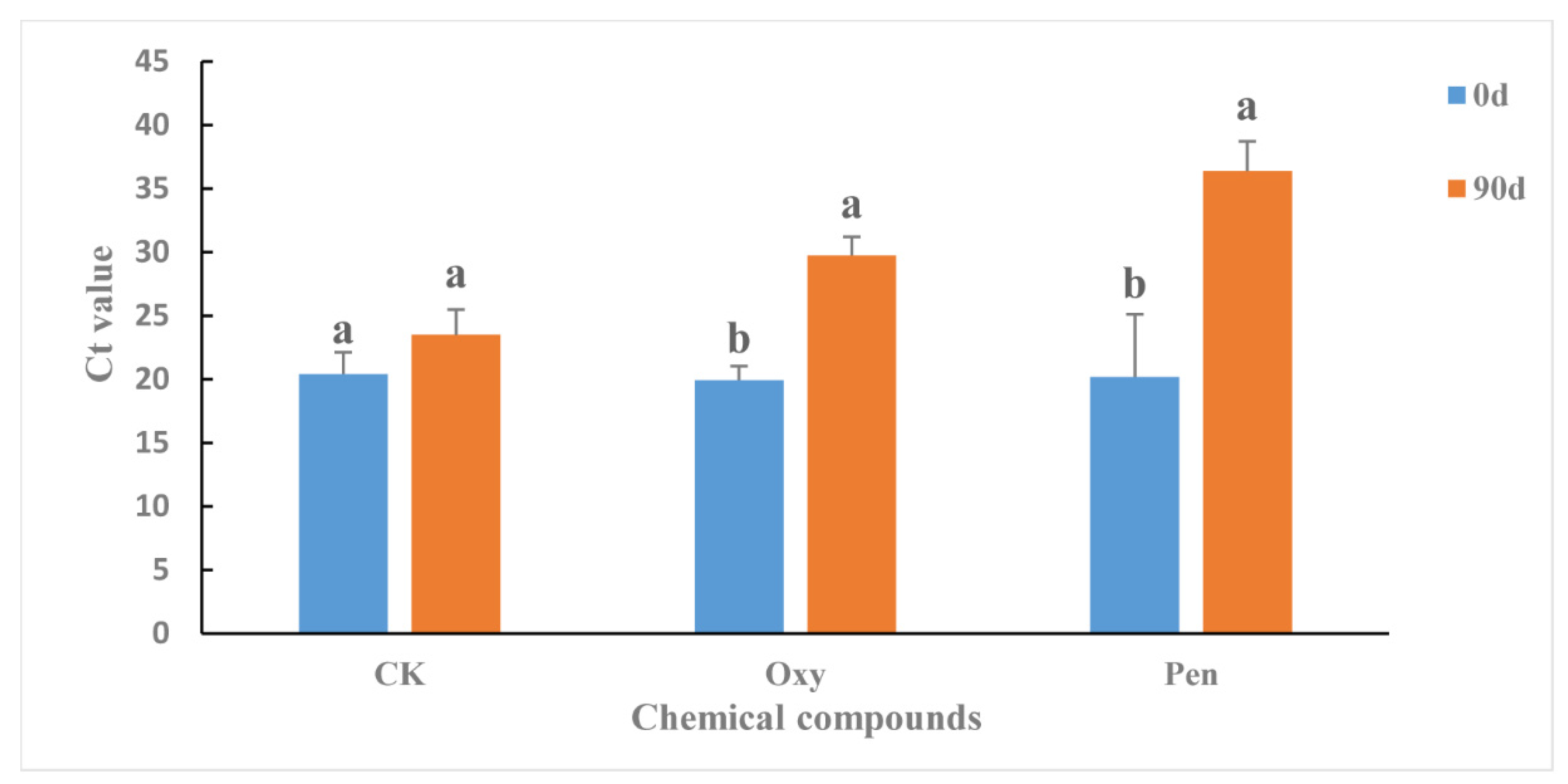
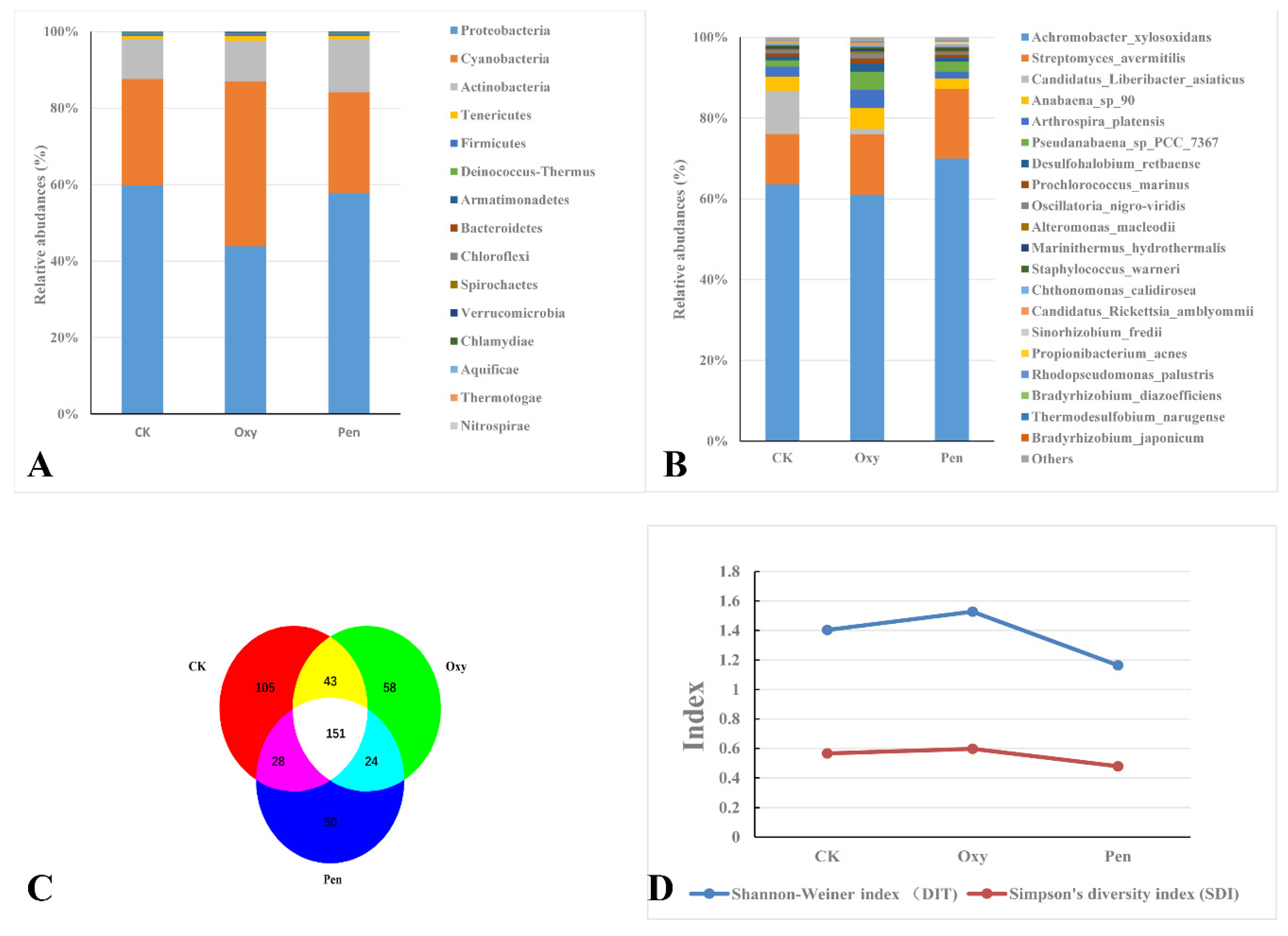
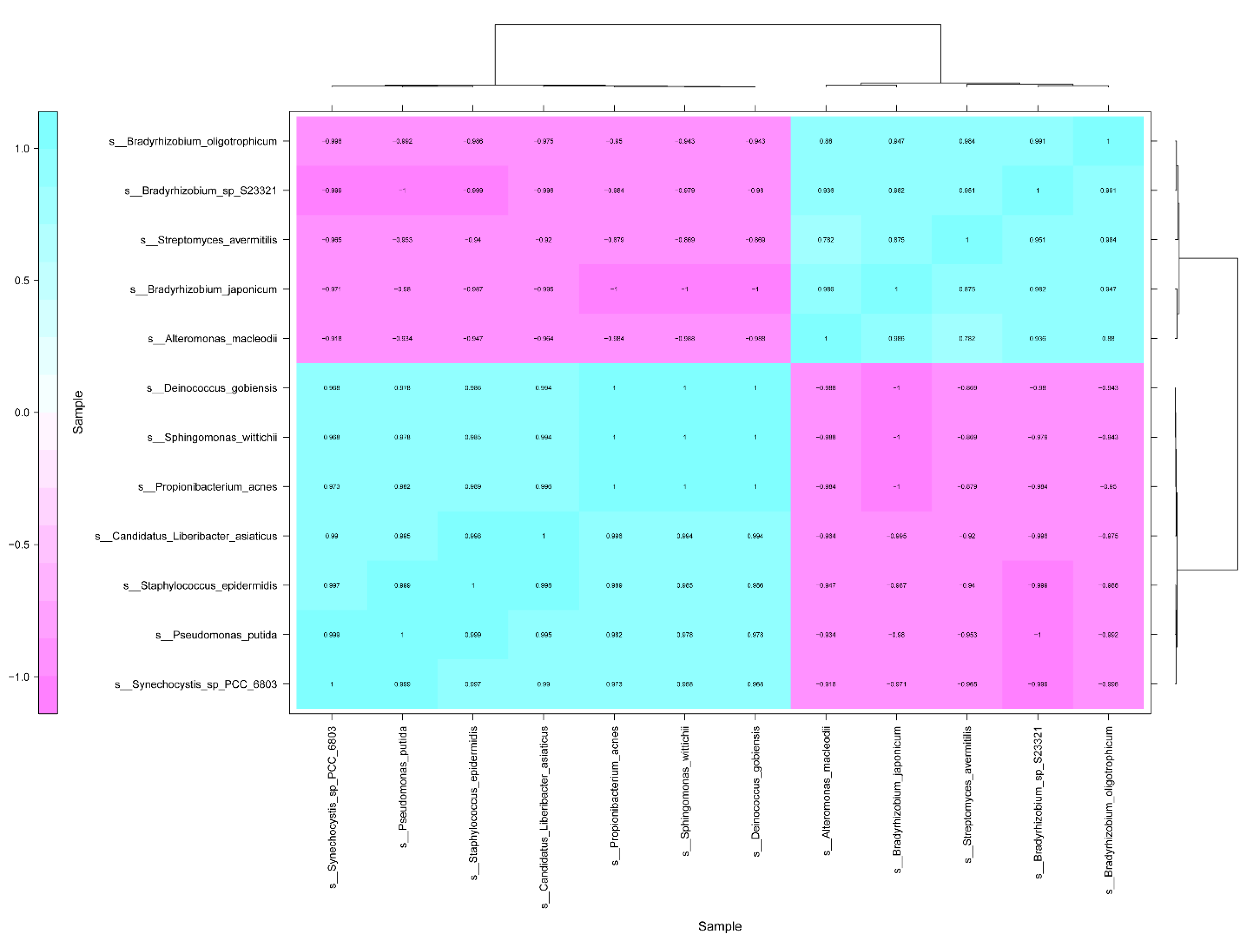
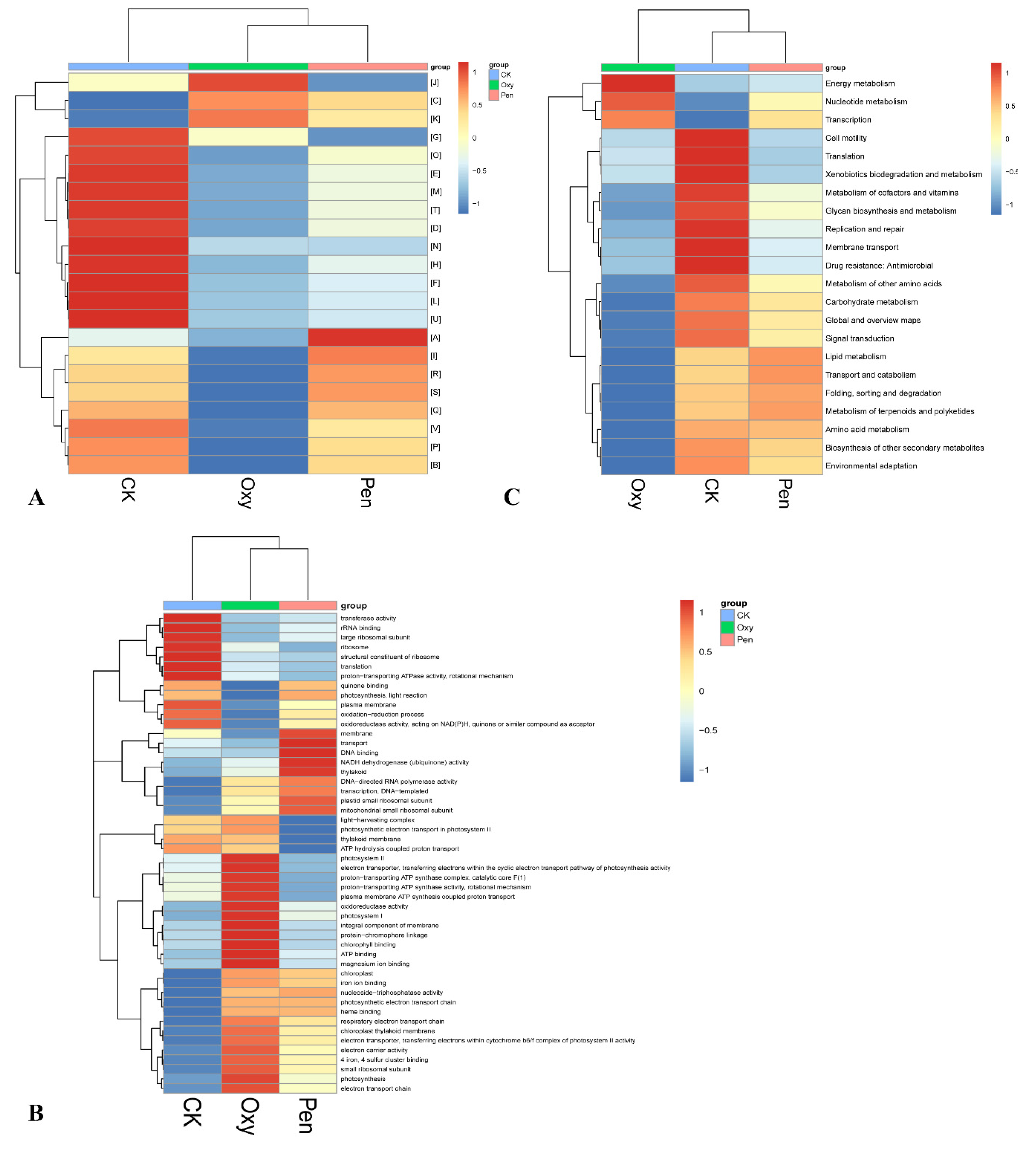

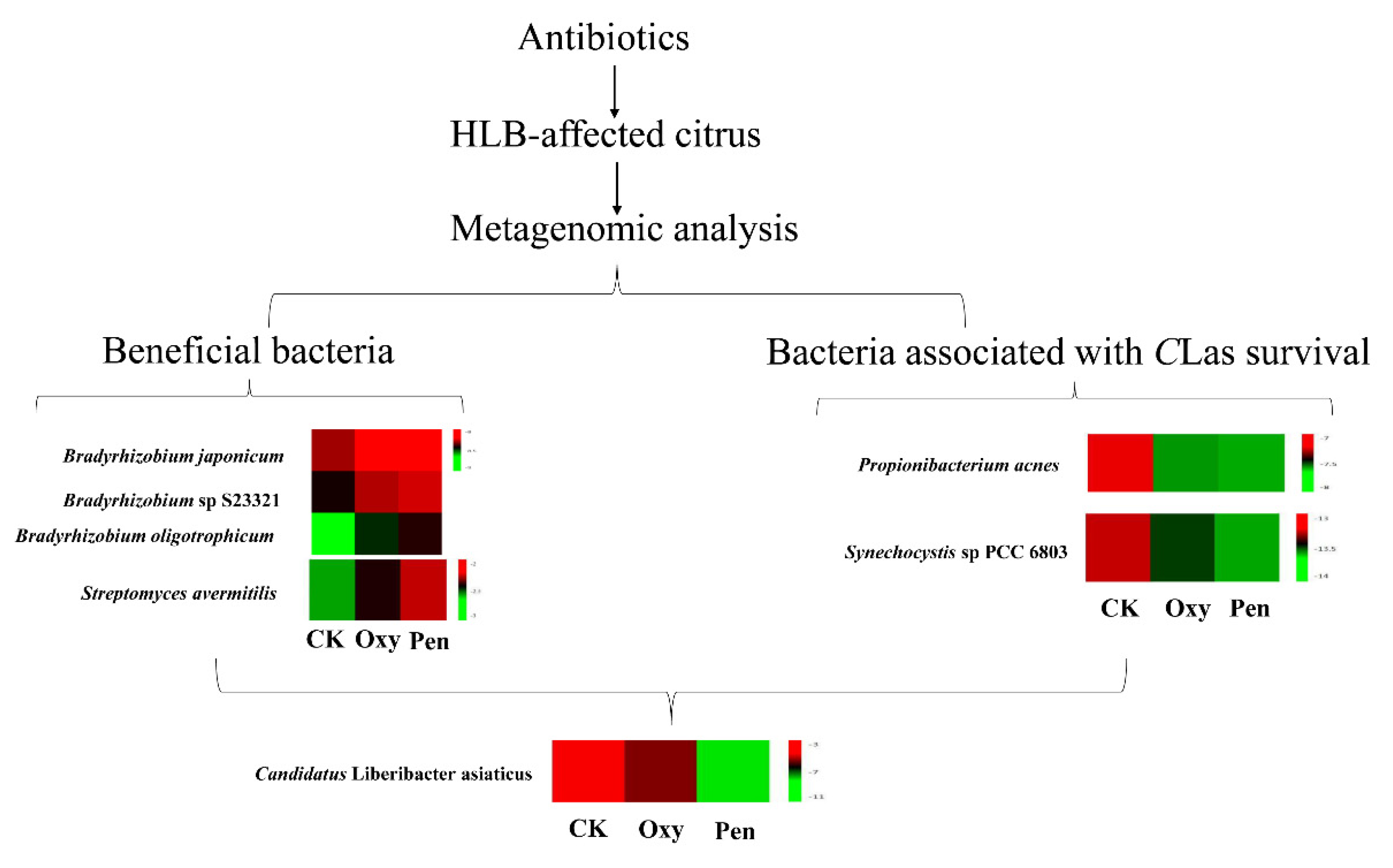
| Treatment | Raw Data (bp) | Clean Data (bp) | Clean Reads | GC (%) | Q20 (%) | Q30 (%) |
|---|---|---|---|---|---|---|
| CK | 794,635,500 | 676,465,200 | 2,254,884 | 42.81 | 93.88 | 87.72 |
| Oxy | 1,228,026,300 | 1,034,652,000 | 3,448,840 | 42.13 | 94.84 | 89.12 |
| Pen | 853,398,900 | 735,906,900 | 2,453,023 | 40.74 | 94.39 | 88.5 |
| Anno_Database | Annotated_Number | 300 ≤ Length < 1000 | Length ≥ 1000 |
|---|---|---|---|
| COG_Annotated | 1351 | 146 | 2 |
| GO_Annotated | 1296 | 133 | 1 |
| KEGG_Annotated | 1796 | 147 | 2 |
| Nt_Annotated | 2145 | 216 | 5 |
| Pfam_Annotated | 2222 | 231 | 4 |
| Swissprot_Annotated | 2548 | 223 | 4 |
| All_Annotated | 3380 | 242 | 5 |
Publisher’s Note: MDPI stays neutral with regard to jurisdictional claims in published maps and institutional affiliations. |
© 2020 by the authors. Licensee MDPI, Basel, Switzerland. This article is an open access article distributed under the terms and conditions of the Creative Commons Attribution (CC BY) license (http://creativecommons.org/licenses/by/4.0/).
Share and Cite
Yang, C.; Hu, H.; Wu, Y.; Lin, X.; Fan, G.; Duan, Y.; Powell, C.; Ancona, V.; Zhang, M. Metagenomic Analysis Reveals the Mechanism for the Observed Increase in Antibacterial Activity of Penicillin against Uncultured Bacteria Candidatus Liberibacter asiaticus Relative to Oxytetracycline in Planta. Antibiotics 2020, 9, 874. https://doi.org/10.3390/antibiotics9120874
Yang C, Hu H, Wu Y, Lin X, Fan G, Duan Y, Powell C, Ancona V, Zhang M. Metagenomic Analysis Reveals the Mechanism for the Observed Increase in Antibacterial Activity of Penicillin against Uncultured Bacteria Candidatus Liberibacter asiaticus Relative to Oxytetracycline in Planta. Antibiotics. 2020; 9(12):874. https://doi.org/10.3390/antibiotics9120874
Chicago/Turabian StyleYang, Chuanyu, Hanqing Hu, Yihong Wu, Xiongjie Lin, Goucheng Fan, Yongping Duan, Charles Powell, Veronica Ancona, and Muqing Zhang. 2020. "Metagenomic Analysis Reveals the Mechanism for the Observed Increase in Antibacterial Activity of Penicillin against Uncultured Bacteria Candidatus Liberibacter asiaticus Relative to Oxytetracycline in Planta" Antibiotics 9, no. 12: 874. https://doi.org/10.3390/antibiotics9120874
APA StyleYang, C., Hu, H., Wu, Y., Lin, X., Fan, G., Duan, Y., Powell, C., Ancona, V., & Zhang, M. (2020). Metagenomic Analysis Reveals the Mechanism for the Observed Increase in Antibacterial Activity of Penicillin against Uncultured Bacteria Candidatus Liberibacter asiaticus Relative to Oxytetracycline in Planta. Antibiotics, 9(12), 874. https://doi.org/10.3390/antibiotics9120874





